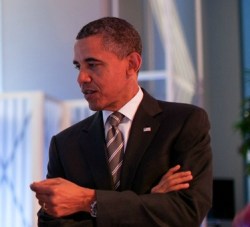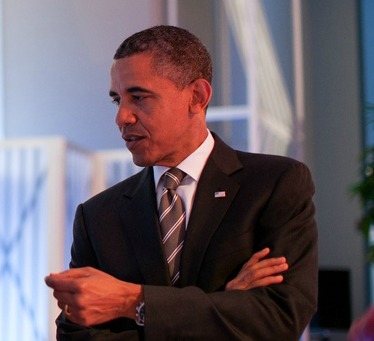
Photo by The White House.
What are the possibilities and prospects for action on climate change if Barack Obama is reelected?
Real talk: Obama will get very little done on climate or energy domestically, especially if Republicans keep the House, most especially if they win the Senate too. The reasons are drearily familiar: deep polarization, corporate influence, and the 60-vote threshold in the Senate. Unless some large and unanticipated exogenous force knocks the system out of equilibrium, we can expect more of what the first term delivered, which is modest (read: woefully insufficient) progress on efficiency and clean energy.
But I’ve been thinking lately that Obama might still be able to make progress on climate through foreign policy.
It’s clear that Obama sees climate as a legacy issue, something that could improve the world in an enduring way. In a recent piece on Obama’s second-term prospects, Ezra Klein said: “Beyond the deficit, Obama’s advisers see two big unfinished pieces of business from the first term: climate change and immigration reform.” On the campaign trail, Obama has mentioned, in the context of a second-term agenda, “the long-term challenges that we’re facing in terms of energy independence and climate change.” In a recent Rolling Stone interview, Obama said: “I will be very clear in voicing my belief that we’re going to have to take further steps to deal with climate change in a serious way.”
But “legacy” and “long-term” are apparently not for the here and now, because as far as I know, he hasn’t mentioned climate change since, not even during the recent drought. He’s clearly not trying to make it part of his mandate in this election.
But! Presidents have a freer hand in foreign policy, and that’s where they often make their mark, particularly in a second term, as both Klein and Ryan Lizza of The New Yorker have pointed out. Both mention that Obama’s team anticipates a “pivot” or “rebalancing” away from the Middle East and toward the Asia-Pacific region. Climate could be part of that pivot.
Remember, in Copenhagen, Obama pledged that the U.S. would hit the near-term Waxman-Markey climate-change goal: 17 percent cuts in CO2 emissions below 2005 levels by 2020. The Waxman-Markey bill was never passed, but it turns out the U.S. is in fact reducing emissions — more than any other country in the world! Progress is being made. Admittedly, some of it, probably the bulk, has nothing to do with climate policy. Nonetheless, it gives Obama and the U.S. some rare credibility with which to try and reengage and reshape international climate work.
The situation internationally is similar to the situation domestically: For the time being, top-down Grand Solutions aren’t going to happen. The pathetic outcomes at Copenhagen and Cancun and Durban have made that clear. For all the exhortations from greens to lead, there’s only so much the U.S. president can do to generate consensus among the 192 nations of the UNFCCC.
What’s needed is for Obama to put bottom-up solutions at the center of his foreign policy. That means deals and treaties between states, regions, and other subnational entities. It means bilateral and multilateral deals among small groups of countries with common interests. It means, rather than one Climate Solution, a focus on the various bits and pieces of a solution: cities, sea-level rise, deforestation, solar manufacturing, carbon sequestration, and the like. Scholar David Victor has lots of ideas along these lines; check out my review of his book. His basic insight is that no international process or treaty can push nations beyond what they see as their own self-interest. So to at least get the climate ball rolling, we need to pay more attention to which aspects of mitigation and adaptation are in which countries’ interests.
There are plenty of measures that can take a bite out of climate while also creating near-term, local benefits. There’s a handy list of 14 of them in a recent paper in Science called “Simultaneously Mitigating Near-Term Climate Change and Improving Human Health and Food Security,” which focuses mainly on methane and soot. (David Biello has a nice write-up of the paper.) And of course growth in cleantech industries has both local and global benefits as well. There are plenty more places to look for win-win-opportunities.
This focus ought to fit neatly with the Asia-Pacific pivot. If the U.S. wants to build relationships in the region, we can do it by engaging on the knot of problems the region most desperately needs to solve: how to continue developing economically, bringing people out of poverty, without choking the air and water with poisons. How to grow local efficiency and clean energy industries that generate jobs and wealth. How to plan for unavoidable climate impacts. Focused on these challenges, America’s expertise and money can do good and create good will.
The current skirmish with China over solar subsidies and tariffs highlights the need for what Michael Liebreich referred to in our interview as a “global industrial policy.” The worst thing that could happen in clean energy is an escalating series of trade wars and protectionist barriers that play for short-term national advantage at the expense of global welfare. There is plenty of work to go around and dire need for low-cost low-carbon technologies. The U.S. should be working to find areas of economic cooperation, non-zero-sum games, that make the best use of each country’s unique strengths. Above all, the U.S. should be working with the region on innovation policy, coordinating and accelerating efforts to drive down the costs of cleantech.
International climate work badly needs a kick in the ass, a new sense of life and momentum. One more failed climate summit isn’t going to do it. If Obama wants to create a foreign policy legacy for his second term, he should focus on reorienting international climate policy toward mutually beneficial, bottom-up solutions. He should make America a catalyst, a constructive, creative force for practical progress on climate. It’s not the Kyoto-on-steroids global climate agreement greens want, but it could make a real difference, and I suspect historians — and future Earthlings — would look upon it kindly.



